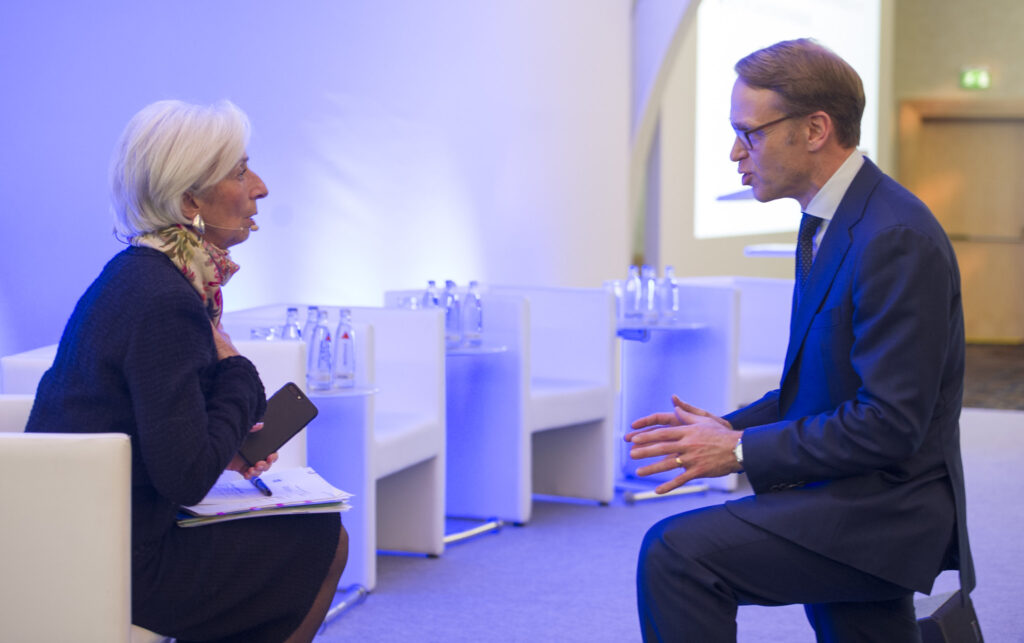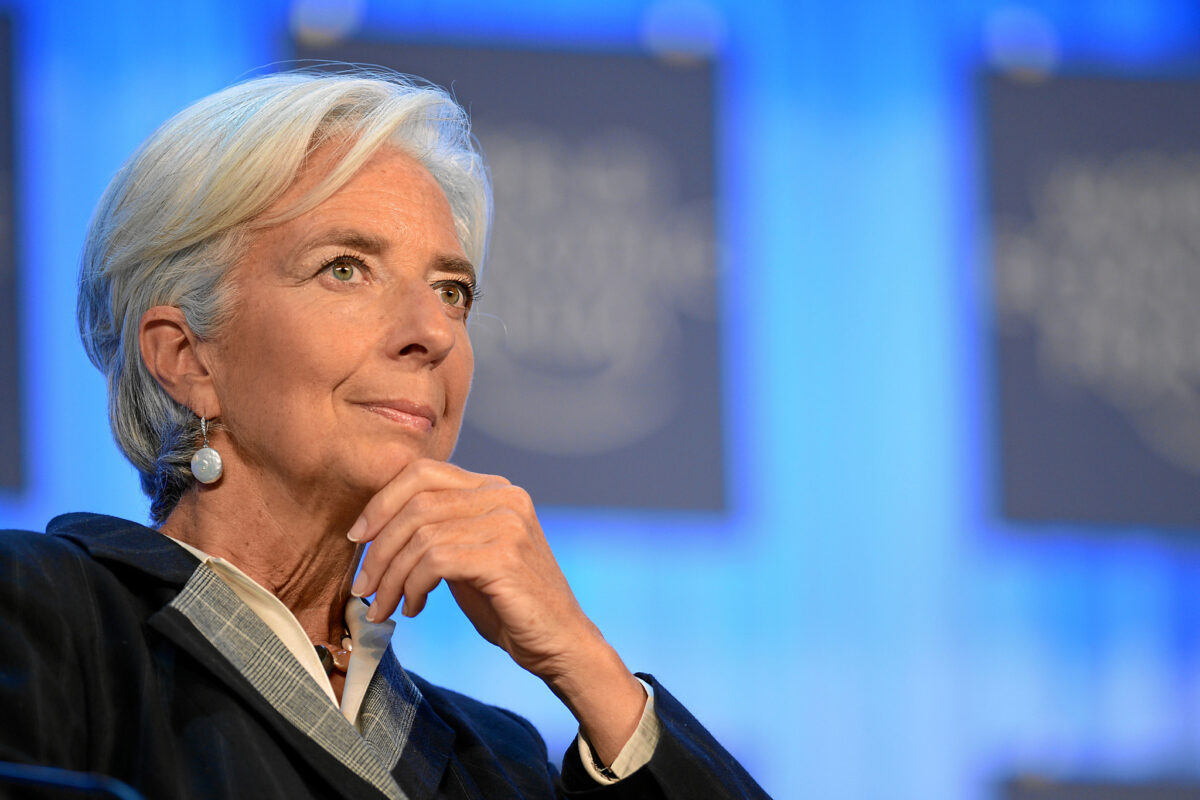An Outsider on the Inside
Christine Lagarde
Monetary hawk or dove, interventionist or laissez faire, insider or outsider: the thoughts and convictions of European Central Bank (ECB) President Christine Lagarde are largely hidden under a cloak of pragmatism. She is certainly an outsider in the universe of central bankers. A soft-touch feminist at heart with an impeccable sense of style, a shrewd political operator, and trouble shooter par excellence with an impressive list of accomplishments.
When the going gets tough, Christine Lagarde has often been called upon to broker a deal or find the solution to a conundrum that baffles lesser minds. In a word: she gets going and likens that to being suspended from a ‘glass cliff’ – as opposed to bumping against a glass ceiling – a phenomenon whereby a complex and hazardous job is handed to a woman, making her success improbable, and affording men a measure of plausible deniability.
A surprise candidate for one of Europe’s top jobs, Ms Lagarde – an antitrust lawyer by training – has big shoes to fill. Her predecessor, Italian economist Mario Draghi (aka Super Mario) expertly steered the 19-strong Eurozone through its first existential crisis, including the near bankruptcies of Greece and Spain.
Two Words
Ms Lagarde boasts a singularly impressive résumé that includes many firsts. She was the first chairwoman of the prestigious Baker McKenzie law firm of Chicago; the first woman to become finance minister of a G7 economy, and the first woman central banker. She also excelled at competitive synchronised swimming as a member of the French national team.
Barely settled into her new job, Ms Lagarde faced a steep learning curve and suffered a baptism of fire as the first wave of the Corona Pandemic sent economies into a tailspin, promptly submerging the Eurozone into its worst post-war recession. With all eyes trained on the ECB in Frankfurt, Ms Lagarde acted quickly and decisively, emulating her predecessor’s (in)famous ‘whatever-it-takes’ warning – the three words that reverberated throughout the financial universe and saved the euro by instantly calming agitated markets during the hectic days of the Greek debt crisis in mid-2012.
In 2020, Ms Lagarde needed just two words to bolster investor sentiment and calm the waters: ‘no limits’. She was as good as her word and no trader or hedge fund manager dared challenge the ECB to a showdown. The hastily organised Pandemic Emergency Purchase Programme (PEPP), now being tapered, injected €1.85 trillion into the Eurozone economy on top of a series of other asset purchase initiatives totalling some €3.3 trillion, pushing the bank’s balance sheet well north of €8 trillion.
Slips
With numbers that big, market watchers tend to follow Ms Lagarde’s every move and weigh her every word. Early-on in the pandemic she slipped when commenting that it was not her or the ECB’s job to ‘close the spread’ in sovereign debt markets. The comment, a regrettable faux pas, triggered the largest single-day drop in Italian bond prices in over a decade.
Though Ms Lagarde apologised profusely for her poor communication skills, and back pedalled quickly, she also clarified that the ECB remained ‘fully committed’ to avoiding any fragmentation in the euro area. In other words: Italy was to be kept safe under the ECB’s monetary umbrella.
Soon after becoming Finance minister of France in 2007, Ms Lagarde gained a measure of notoriety as ‘Madame la Gaffe’ for her penchant of landing in hot water. Though she did manage to keep President Sarkozy’s more esoteric economic ideas in check, Ms Lagarde also angered many with her Americanised management style and philosophy. Her barely veiled criticism of France’s almost sacrosanct 36-hour work week and the five weeks of annual leave enjoyed by most, did little to enamour her with French voters. Nonetheless, the Financial Times in 2009 ranked Ms Lagarde the best finance minister of the Eurozone for her brave efforts to cut the deficit and reduce debt levels.
American Sojourn
Ms Lagarde lived in the United States in the 1980s and between 1999 and 2005. Before that, she spent a year as an exchange student with a family in Maryland where she is remembered for adding some continental flair and glamour to an otherwise unremarkable, if not drab, suburban environment.
During the Watergate Scandal and the impeachment procedure against President Richard Nixon that followed, the young Ms Lagarde briefly interned at the congressional office of Republican Senator for Maine William R Cohen who needed a French speaker for his partly Francophone constituency. Speaking to the Washington Post in 2011, she later called her year in Maryland ‘one of the most formative’ of her youth.

IMF and Greece
In late June 2011, the executive board of the International Monetary Fund (IMF) elected Ms Lagarde as its managing director. Just like her experience years later at the ECB, she was almost immediately confronted with a crisis of magnitude when Greece faced an acute cash crunch that threatened to spill over to other weak Eurozone economies such as Spain and Portugal.
The often-forgotten origin of that sovereign debt crisis was the decision of credit rating agencies to downgrade Greek bonds to junk status in April 2010 after the country reported lower than expected GDP growth. Also, parts of the country’s debt had been kept off the books via cross currency swaps – a legal, if contentious, manoeuvre making use of a loophole in the Maastricht rules on debt and deficits.
Of that time, she remembers that the IMF hastily cobbled together a massive bailout package, putting close to a trillion dollars in play to dissuade any market attack on Eurozone member states. However, under the First Economic Adjustment Programme – a joint operation of Eurozone countries and the IMF – Greek received a €110 billion bailout, conditional on the implementation of a long series of austerity measures. A year later, the partners forced commercial banks to accept a fifty percent ‘haircut’ (write-off) on significant tranches of Greek debt.
The almost draconian austerity imposed on Greece depressed the country’s economy and lopped a quarter of the country’s GDP. Ms Lagarde later was to recognise that the rescue package prepared for Greece fell well short of what was required. In 2015, the IMF belatedly concluded that Greece’s debt burden was ‘unsustainable’ and economic recovery ‘unlikely’ absent a massive write-off. A year later, the fund tuned out after Eurozone countries refused to countenance measures to provide meaningful and structural debt relief.
German Jitters
During and after the Greek debt crisis, Ms Lagarde clashed frequently, and sometimes, publicly, with Germany’s guarding of fiscal and monetary probity such as the combatant former Finance Minister Wolfgang Schäuble who may have been a passionate believer in Franco-German cooperation and European integration but was also vociferously critical of French mercantilism and lax fiscal standards. It was Schäuble who in 2016 opposed any additional discounts on Greek debt and caused the IMF to withdraw from any future contributions towards the restructuring of that country’s burden.
Unsurprisingly, Germany was less than thrilled at Ms Lagarde’s nomination to lead the European Central Bank amid suggestions she was likely expand the bank’s bond-buying programme. At the time, Berlin made no secret that it had preferred the hawkish Jens Weidmann, then head of the Bundesbank, to succeed Mario Draghi. The concern over Ms Lagarde centred on fears that she could favour a more redistributive – and politicised – approach to the monetary union, possibly steering the ECB away from its price-stability mandate.
In late September 2019, just one month before Ms Lagarde was to start in her new job, Germany’s most senior official at the ECB, Sabine Lautenschläger, unexpectedly resigned from the ECB executive board. She did so long before her term was due to end and without giving an explanation. It is, however, widely believed that Ms Lautenschläger’s departure was caused by the ECB’s decision to resume and expand quantitative easing (QE) in the hope of stoking inflation towards the stated goal of two percent. She was the third German to bow out over ‘excessive’ bond-buying. In 2011, both Axel Weber, former president of the Bundesbank, and Jürgen Stark, member of the ECB executive board, cut their term short for the same reason.
The exit of Sabine Lautenschläger allowed Christine Lagarde to quickly consolidate her hold over the ECB with a more conciliatory German on her team. Ms Lautenschläger’s replacement, Isabel Schnabel, helpfully cautioned against making the European Union a scapegoat for all perceived national ills, pointing to Brexit as evidence of the damage caused by misinformation. Ms Schnabel also repeatedly came out against the idea that German savers and taxpayers are being asked to foot the bill of troubled Eurozone ‘Club Med’ members.
Frankfurt Skyline
Ms Lagarde’s ECB is everything the German Bundesbank, also headquartered in Frankfurt, is not. The differences are evident even in architecture, contrasting the gleaming glass tower that houses the ECB with the austere brutalist structure that is home to the Bundesbank. Not since its first president, the Dutchman Wim Duisenberg, have the Germans been able to get a firm grip on the ECB and its policy. Though it, of course, has considerable heft in setting European monetary policy, the Bundesbank and its hawks had to let go of their laser-like focus on stability. Their rigid attitude – derided by Mario Draghi as ‘nein zum allen’ (‘no to everything’) – hasn’t helped either. Ever larger bond-buying programmes have been speedily implemented over German objections.

Christine Lagarde visibly enjoys shaking things up, pushing boundaries, challenging convention, and causing ‘men in grey suits’ to break a sweat. She is not as nerdy (or academic) as, say, former US Federal Reserve Chair and current US Treasury Secretary Janet Yellen or former Bank of England Governor Lord Mervyn King. She even had a ‘psychedelic’ carpet installed in her office at the French Finance Ministry to get the ‘suits’ confused and ushered out of their comfort zone.
Her experience in politics is a definite plus for a central banker such as when Ms Lagarde, at the beginning of the Corona Pandemic, exhorted Eurozone governments to share the burden of providing economic relief, explaining that monetary policy alone could not possibly provide the stimulus needed and a relaxation of fiscal policy was called for. Thus, she ventured onto terrain seldom, if ever, visited by central bankers.
Ms Lagarde, the pragmatist, also showed a willingness to rip up the rule book in the face of severe crisis. In early 2020, as the first wave of the pandemic rolled over Europe, she tinkered with the rules governing the ECB’s asset-buying programme which held that the bank was to buy a country’s bonds in rough proportion to its GDP.
Instead, Ms Lagarde ordered the bank to buy additional assets in Spain and Italy. Moreover, she introduced a 1% bonus for commercial banks on their credit portfolio, encouraging them to keep distributing ECB funds to private business. Earlier versions of QE saw banks redeposit their ECB funds at the central bank in a rather cynical form of arbitrage whereby bankers eagerly pocketed the interest rate differential and refused to supply credit to businesses.
Gender and Green
Battling the pandemic’s fallout has so far largely prevented Ms Lagarde from implementing her cherished green agenda. Climate change and gender equality, two issues she vigorously promoted at the IMF, are soon to become policy pillars at the ECB, much to the chagrin of most monetary policymakers – the men in grey suits. Where her predecessor Mario Draghi often spoke about inflation, and the need to either control or stimulate it, Ms Lagarde prefers to talk about climate change, an issue mostly ignored by Mr Draghi. Only of late, with inflation roaring back, has Ms Lagarde given the phenomenon its due.
Rather controversially, Ms Lagarde repeatedly indicated that she considers the fight against climate change part of the ECB’s primary price-stability mandate. She is determined to steer any future QE initiatives towards green businesses and initiatives – and away from polluters. This approach horrifies most central bankers who fear mission creep and argue that it is the job of politicians to tackle environmental degradation. Former Bundesbank President Jens Weidmann is on record saying that climate change has little to no bearing on prices and by extension on inflation.

On gender equality, Ms Lagarde is adamant that it is good both for business and stability. She points to exhaustive research conducted by the IMF that shows a straightforward correlation between the number of women on the board of banks and financial supervisors, and institutional stability. Ms Lagarde maintains that the fate of Lehman Brothers – the spark that set off the 2009-10 banking crisis – might have been different if it had been Lehman Sisters. However, she admits that gender equality remains an uphill battle, especially at a male-dominated bastion such as the ECB.
Boys Club
When she became president in 2019, Ms Lagarde was the only woman at the bank’s governing council. Since then, that number has doubled – to two. Of the 63 central bank governors who have served on the council, only one was female. In an attempt to get a better gender balance, the ECB has set a target of filling ‘half or more’ of top echelon positions with women. Ms Lagarde also objects to the bank’s long-standing refusal to grant more generous paternity leave which remains capped at two weeks, as opposed to six months of maternity leave.
The imbalance at the ECB top has even caught the attention of the European Parliament which mulls an intervention of sorts. Helena Dalli, European Commissioner for Equality, said that high profile public institutions such as the ECB should lead by example and noted that the central bank has the power to reject candidates proposed by national governments. This, however, is unlikely to happen. Though in 2012 the European Parliament opposed the nomination of Yves Mersch, former head of the central bank of Luxemburg, to the ECB executive board on gender grounds, the move merely delayed the appointment but did not stop it.
New Keynesian Perspective
After a solid year of deliberation, the ECB announced its new and revised monetary policy strategy in June 2021. Two elements stand out: inflation target symmetry and the use of ‘especially forceful or persistent’ measures when the Eurozone economy is close to the effective lower bound (ELB), i.e., the point at which cuts in interest rates no longer have a positive effect on aggregate demand; or the point at which further interest rate cuts would cause adverse effects in the financial sector.
The symmetry concerns unwelcome deviations – negative a positive alike – from the ECB inflation target of two percent over the medium term. Both eventualities should spark equally forceful measures. However, this is where ELB becomes relevant.
Though the central bank can – in principle – always hike interest rates in response to an inflation spurt, it may not be able to cut them if the room to do so is limited or absent as has been the case as of late. With the substantial decline in the natural rate of interest observed over the past decade, the monetary wiggle room between the natural rate of interest and the effective lower bound has become rather cramped – rendering the desired response symmetry ineffective if not impossible to attain. This is precisely what happened during the last ten to fifteen years as interest rates dropped and deflation loomed large with central banks almost desperately providing shock treatment to lacklustre economies in the form of QE.
Though the ECB monetary policy strategy now embarks into technicalities that may appear esoteric to the untrained eye or mind, its fundamentals are fairly simple. Symmetry is mostly desired to match an economy’s risky steady state – a sort of natural equilibrium – to the target inflation rate.
In this state, the expectations of economic actors are kept in line with those of monetary policymakers. However, the limits and threats imposed by ELB could force the central bank to show a greater tolerance for above-target inflation than for below target developments. This may well introduce inflation bias (expectation) which then alters the risky steady state and undermines the central bank’s mission to keep price levels steady and predictable.
The above but serves as the theoretical foundation of the ECB’s formal adoption of, and adherence to, New Keynesianism which supports, amongst others, central bank asset purchases as a valid instrument to compensate for (impossible) interest rate cuts below ELB.
Again Germans
Again, the Germans may not be so pleased but may possibly enjoy the last laugh as in its March quarterly economic review the ECB came out surprisingly hawkish and determined to unwind the last of its asset purchase programmes by next September. The upswing of inflation and the damage being wrought by spikes in energy prices and Mr Putin’s War in Ukraine caused different policymakers to propose differing views – ‘in all directions’, as Ms Lagarde put it succinctly.
Analysts quickly picked up on the plethora of views at the ECB top and pushed the yield on Italian ten-year bonds up by twenty basis points in the expectation that a coordinated monetary and fiscal response – the (in)famous bazooka – to the sudden price shock is not likely to materialise. Ms Lagarde preferred to speak of a ‘balanced’ approach; one that entrusts the heavy lifting to the fiscal cavalry as the monetary troops have been exhausted.
Forecasts for the Eurozone are currently all over the place with GDP expected to gain 3.7% this year, down from 4.2%. The ECB quarterly review now sees average inflation heading towards 5.2%, up from the 3.2% predicted in Q4 2021. In response to the revised numbers, BlackRock Chief Macro Strategist Rupert Harrison fumed that the ECB persists in its ‘policy errors’ with growth forecasts ‘unrealistic and engineered’ to allow the monetary hawks an opportunity to kill off asset purchases altogether. According to Mr Harrison, the impact of Mr Putin’s War on the Eurozone is being severely underestimated.
A popular hashtag on Twitter, #whatwouldMariodo, is awash with criticism of Ms Lagarde and her cornered bank now largely bereft of monetary instruments and caught between rising inflation on the one hand and on the other a Eurozone economy struggling with energy prices that threaten to undermine consumer confidence and collapse demand. To raise interest rates in such a volatile climate – the market expects a first quarter-point hike in October – is a risky proposition indeed.
Fundamental Differences
To her critics, insofar as they are not ignored, Ms Lagarde suggests that the Eurozone is in a fundamentally different spot than the US or UK as continental Europe has been much more successful in keeping its workers employed. In fact, the Eurozone has currently more people in jobs than before the Corona Pandemic hit. This has helped business retain the talent and skills needed to fully cash in on the post-lockdown economic upswing.
Unemployment now stands at its lowest since the euro’s creation. However, wage pressures have been minimal. Ms Lagarde surprised many by suggesting that she would welcome ‘somewhat faster’ wage growth. The Eurozone also does not suffer from the negative labour supply that the UK inflicted upon itself with Brexit.
Ms Lagarde seems unwilling to be intimidated by inflation’s sudden but not entirely unexpected return. She played down chances of a ‘measurable tightening’ of monetary policy, promising only gradual changes. Although she signalled ‘unanimous concern’ within the executive board over inflation, she also saw no rush to any premature conclusions, saying the outlook remains ‘way too uncertain’.
With the Bank of England and the US Federal Reserve soaring high on the wings of their monetary hawks, Ms Lagarde seems determined by conviction to keep the ECB on its moderately dovish path, handing the ‘frugals’ a few minor concessions in order to keep the peace and the overall course unaltered. Tightening policy for credibility rather than fundamental reasons is not on the agenda: This lady is not for turning.
Lagarde on Ukraine War
European Central Bank (ECB) President Christine Lagarde fears that the war in Ukraine may unleash ‘new inflationary trends’ as supply chains are disrupted and energy sources reassigned. Ms Lagarde also warns that the war may pose a risk to growth due to depressed consumer confidence and a demand slump which, in the best of cases, could help limit price pressures.
The recent and sudden surge in energy prices is expected to reduce Eurozone GDP growth by up to 1.4 percentage point and represents a ‘terms of trade tax’ which transfers purchasing power from Europe to energy suppliers. According to Ms Lagarde, higher export prices are only partially able to offset this loss.
Earlier this month, the ECB surprised markets with the announcement that it would wind down and wrap up its multiple asset purchasing programmes. Most analysts had half expected the bank to delay the end of the purchases – or at least maintain a measure of ambiguity about its intentions – considering the economic wildcard introduced by the war and the sanctions imposed on Russia. However, the ECB signalled that it expects to stop bond purchases in the third quarter and soon after begin raising interest rates.
Ms Lagarde indicated that the central bank remains ‘poised to react effectively’ to address any fallout from the war: “We are leaving our options open.” The ECB president promised that any future interest rate hike would be based on the bank’s assessment of the inflationary trend, i.e., the convergence of actual inflation to the long-standing ECB target rate of two percent.
Bleakest Scenario
Even with the war worsening and sanctions tightening – the ‘bleakest scenario’ Ms Lagarde can envision – the ECB expects eurozone GDP growth to reach 2.3% for the year, minimising the risk of stagflation – inflation in the absence of economic growth. By linking the end of its asset purchases to the start of rate hikes, analysts believe that the central bank has created some room to manoeuvre. Dutch Central Bank Governor Klaas Knot, representing the more hawkish wing within the governing council, suggested at least two rate hikes before December. Whilst understandably refusing to discuss the ECB’s monetary policy outlook, Ms Lagarde did hint that the bank won’t move at the same pace as the US Federal Reserve which kicked off a cycle of rate increases in mid-March.
Ms Lagarde explained that the US and Eurozone economies are at different places – she mentioned ‘universes’ – as Europe is much more exposed to the war in Ukraine and to rising energy prices. The ECB president pointed out that Europe is much more dependent on commodity imports than the US. The urgent need to step up the greening of the economy to reduce the dependency on imported oil and natural gas is likely to fuel inflation in the short term.
In a speech delivered at the 22nd annual The ECB and Its Watchers conference in Frankfurt am Main, Ms Lagarde assured that the central bank is determined to secure price and financial stability throughout the eurozone. She called the Russian invasion of Ukraine a ‘war of aggression’ and said it signalled a tectonic shift in European history. Ms Lagarde invoked the spirit of philosopher Bertrand Russell by reminding the audience that “we face an eternal test of how to live without certainty without being paralysed by hesitation.”
Cover photo: ECB President Christine Lagarde at the 2013 World Economic Forum.
- © 2013 Photo (cover) Christine Lagarde by World Economic Forum
- © 2015 Photo Yanis Varoufakis by Brookings Institution
- © 2022 Photo Frankfurt skyline by Jörg Braukmann
- © 2018 Photo meeting Lagarde and Weidmann by Deutsche Bundesbank


